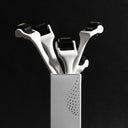Finasteride and minoxidil stand as prominent leaders in the realm of hair loss treatments. Are you pondering the potential of merging these treatments?
Delve into the intricacies of combination therapy as we explore the synergistic effects of Finasteride and minoxidil together.
Table of content
What is finasteride?
Finasteride is an oral prescription medication primarily used to treat male pattern baldness by inhibiting the production of DHT, a hormone linked to hair loss. It's also available under the brand name Propecia.
As your leading source for hair health information over the past 4 years, we never compromise on accuracy. When it comes to your health, you deserve information you can truly rely on - and earning your trust is our top priority.
Here's how Scandinavian Biolabs ensures every piece of content meets the highest standards of accuracy and integrity:
- Credentialed Experts: Our reviewers are actively practicing doctors and medical researchers
- Stringent Reviews: Content undergoes rigorous editing by subject specialists and review by a practicing doctor.
- Evidence-Based: We rely on well-established research from trusted scientific sources like peer-reviewed journals and health authorities.
- Full Transparency: Our editorial standards, writer credentials, reviewer credentials, correction process, and funding are all publicly documented.
- Independent Voice: While we do promote products, we operate in a vacuum to business operations. Our main goal is just an unwavering commitment to providing medically-sound guidance.
You can count on Scandinavian Biolabs to consistently deliver the trustworthy health information you deserve. Read our Editorial Standards.
How does finasteride work?

Finasteride (also Proscar and Propecia) is an oral medication used to treat male pattern baldness. It works by inhibiting the production of the hormone DHT by suppressing the action of 5α-reductase. DHT is a metabolite of testosterone that is involved in hair loss. By inhibiting its production, finasteride medication can help to prevent further hair loss and promote new hair growth.
In clinical trials, finasteride effectively reduces DHT levels by up to 70%. It is typically used daily, and results (like these finasteride before and after pictures) may be seen after 3-6 months of treatment. Finasteride is a safe and effective treatment for male pattern baldness and is available by prescription from a healthcare provider.
You can use finasteride for receding hairline, too.
What is minoxidil?
Minoxidil is an over-the-counter topical solution, originally developed to treat high blood pressure, but later found to stimulate hair regrowth. It works by increasing blood flow to hair follicles, promoting thicker and healthier hair. It's commonly used for treating pattern baldness and is available under brand names like Rogaine.
How does minoxidil work?
Minoxidil is a drug that was initially designed to treat high blood pressure. However, hair growth was found to appear as an unexpected side effect. Minoxidil works by vasodilation of the blood vessels, increasing blood flow and nutrient uptake in the hair follicle. This allows the follicle to produce thicker, healthier hair.
While Minoxidil is not a cure for baldness, it is an effective treatment for many people. In addition, it is an FDA-approved drug for hair loss. So for those who are looking for a way to turn back the clock on their hairline, Minoxidil may be worth a try.
Minoxidil helps against receding hairline, traction alopecia, frontal baldness and temple hair loss.
Which remedy is right for me?

There are two main options for treating androgenetic alopecia: Minoxidil and finasteride. Both are effective against androgenic alopecia but work in different ways and have other side effects.
The question arises, which one is the right remedy for your pattern hair loss?
Finasteride is most effective in people who are already losing their hair, and finasteride results can take up to a year to show.
The downside of finasteride is that it can cause side effects such as decreased libido and erectile dysfunction.
So, what is the right treatment for you?
Minoxidil may be the best option if one starts seeing hair fall.
Finasteride may be the best option if one is already losing hair.
However, both treatments have considerable risks and side effects, so one must consult a medical professional before starting any treatment.

Is there a third option?
Both of them have inrefutable evidence of their effectiveness, but also inrefutable cases of where entire lives have been destroyed - all for a thicker head of hair.
It's not that surprising, considering how both minoxidil was invented in the 50s and finasteride in the 90s.
It's not wrong to call them your dad's hair loss remedy.
To date, there are more and more company actively doing research to find out ingredients and formulas with effective results and no harmful side effects.
Bio-Pilixin® is probably a breakthrough in natural hair growth you've never heard of.
Harnessing stem cell technology, the formula attacks the root of the problem - your cells - to encourage hair regrowth naturally and safely.
The best thing is that they are a holy grail when finasteride is not working, or minoxidil is not working.
In a clinical trial, 97% of users experienced less hair loss in 150 days, without any of the side effects.
As compared to 94% from finasteride and minoxidil COMBINED!
None of the depression, sexual dysfunction or heavy breathing.
What's the difference between finasteride and minoxidil?
There are clear differences between them, but that's what makes combining topical minoxidil and finasteride effective as a hair loss treatment.
Mechanism of action
Minoxidil works by improving blood flow to the scalp which stimulates hair regrowth. You can minoxidil for men and women.
Finasteride works by blocking DHT, a hormone that plays a huge role in male pattern hair loss. For this reason, finasteride is used primarily for male hair loss such as male androgenetic alopecia, NOT female pattern hair loss.
Form

Minoxidil comes in three forms - oral minoxidil, minoxidil foam and liquid.
Finasteride comes in two forms - topical finasteride and oral finasteride.
Length
Minoxidil results can take months to appear, but finasteride results can take up to a year.
Side effects
They both can shed your hair after the first few times of usage. This is called minoxidil shedding and finasteride shedding.
Minoxidil and finasteride side effects list is not entirely different, but there are some differences that are important to consider before starting the hair restoration treatment.
Finasteride side effects after stopping (or PFS for short) should be considered before starting finasteride. The one to look out for is the sexual side effect.
Minoxidil can also cause side effects sexually, mentally and physically.
Unlike topical minoxidil, oral minoxidil might result in unwanted hair growth.

What other treatments or remedies can I use for hair loss?
Other ways you can combat hair loss and encourage hair growth include:
- Scandinavian Biolabs Hair Growth Routine
- DHT blocking foods
- Collagen
- Pumpkin seed oil
- Stinging nettle
- Zinc
- Collagen
- Dutasteride
- Ashwagandha
- Turmeric
- Capilia Longa
- Nanoxidil
- Biotin
- Low-level laser therapy
- PRP therapy
- Hair transplant
All of these have had scientific research done to gauge their effectiveness against female and male pattern hair loss. These are named as alternatives to finasteride and alternatives to minoxidil.

What is combination therapy for hair loss?
Combination therapy is when you use both minoxidil and finasteride treatment for your hair loss.
Minoxidil and finasteride are the two most common treatments, with minoxidil being approved by the Food and Drug Administration (FDA), for androgenetic alopecia.
Both drugs are effective at treating hair loss. When used together, they can provide even better results.
While both minoxidil and finasteride are singularly effective at treating hair loss, they are often used in combination for the best results.
This is because minoxidil can take several months to produce results. In contrast, finasteride may take up to a year to show its full effects.
What could a typical day of combination hair loss therapy look like?

A typical day of combination therapy would involve applying 5% topical minoxidil once a day in the morning and taking finasteride at night.
While there are no guarantees, this treatment regimen has been shown to help slowing hair loss and stimulate new hair growth effectively. With dedication and patience, one may be able to see positive results from combination therapy.
How do finasteride and minoxidil work together for hair loss?
Minoxidil solution can help to prevent further hair loss and thinning hair from occurring, while finasteride can help to regrow lost hair. As a result, these two medications can work together to provide comprehensive treatment for hair loss and help maintain hair density.
Can you take minoxidil and finasteride together?

Yes, you can take minoxidil and finasteride together for more effective results against hair loss. It's called combination therapy.
Are finasteride and Propecia the same thing?

Regarding hair loss treatments, few products are as well-known as Propecia. But is there a difference between finasteride and Propecia?
Many people don't realize that Propecia is just the brand name for the drug finasteride.
Finasteride is a prescription hair loss medication used to treat male pattern baldness and is the active ingredient in Propecia.
This works by inhibiting the production of DHT, a hormone that plays a role in hair loss.
While Propecia is a treatment for male pattern hair loss, generic finasteride is also available.
So, whether you choose Propecia or finasteride, you get the same active ingredient.
Conclusion
The journey to effectively treat hair loss and combat hair thinning has seen significant advancements with the introduction of potent solutions like Finasteride and Minoxidil.
These treatments have not only proven to be effective but have also opened doors to combination therapies that offer synergistic results.
Whether you're at the onset of hair thinning or are battling progressive hair loss, understanding these remedies and their functions can offer a beacon of hope.
Moreover, as research continues and more solutions come to the forefront, those seeking to treat hair loss will find an ever-expanding arsenal of tools at their disposal.
It's essential to stay informed, consult with medical professionals, and choose the path that aligns best with your needs and health.
FAQs
Can minoxidil and finasteride regrow hair?
Yes, using Minoxidil and Finasteride together can enhance hair regrowth results. Studies have shown that combining 0.1% topical Finasteride with a 5% topical Minoxidil solution can increase hair count and reduce bald areas.
Can I stop minoxidil after finasteride?
It's often recommended to overlap both treatments for 4 months and then cease minoxidil. However, be cautious as stopping minoxidil might result in telogen effluvium, even with ongoing Finasteride treatment, as indicated by Tosti et al.
Will I lose existing hair if I stop minoxidil?
Yes, discontinuing minoxidil may lead to hair loss. Any hair growth or maintenance achieved with minoxidil could reverse, as its benefits only persist while the medication is applied.
Is finasteride permanent?
No, the effects of finasteride aren't permanent. Once you cease intake, any preserved hair might start shedding, reverting to the hair loss pattern prior to medication usage.
References:
- https://www.cochranelibrary.com/central/doi/10.1002/central/CN-00490807
- https://pubmed.ncbi.nlm.nih.gov/29972712
Read more:







